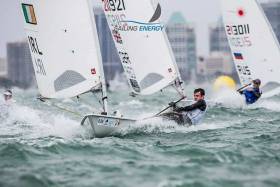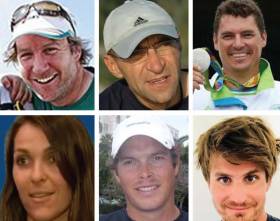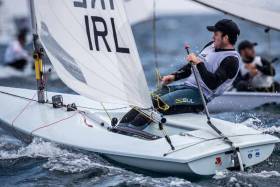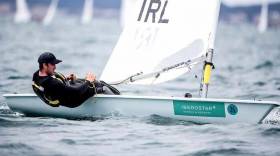Displaying items by tag: olympic sailing
With the prospect of the Tokyo Olympic Regatta just two years away, the first qualification opportunity for Irish sailors takes place in Denmark at the start of August. A total of 14 Irish sailors will be competing and the bulk of them were in Dublin this morning for a pre-event briefing and media opportunity but the Olympic Silver Medalist Annalise Murphy was absent due to Volvo Ocean Race duties.
As Afloat.ie previously reported, The Sailing World Championships will be staged in Aarhus, Denmark from 30th July to 10th of August 2018 and 1,500 competitors from 100 countries are expected.
Importantly, the World Championships are the first of three opportunities for each country to win a single place at each of 10 sailing events for the Olympics. Once qualified, selection and nomination of athletes will follow.
Ireland has sailors competing in four classes of boats: 49er, Laser Standard, Laser Radial, and Finn.
Olympic silver medallist Murphy, currently competing in the closing stages of the Volvo Ocean Race will not attend Aarhus but recently announced that she will switch discipline from the single-handed Laser Radial to the double-handed women's 49erFX skiff event. She has paired up with Katie Tingle and they will begin training together in July.
Murphy's switch to the skiff event leaves two rising stars in the Laser Radial as Howth's Aoife Hopkins and Lough Derg's Aisling Keller contest the single-handed class.
Over in the men’s events, the Laser Standard rig features Rio 2016 Olympian Finn Lynch from Carlow and Belfast Lough sailor Liam Glynn competing in this demanding event.
The men's 49er skiff class features two-time Olympic veteran Ryan Seaton from Belfast who is teamed with Cork's Seafra Guilfoyle. Three other teams from the Irish Sailing Development Squad will also head to Denmark, including Dun Laoghaire's Sean and Tadgh Donnelly; Howth's Robert Dickson and Sean Waddilove; and Mark Hassett with Oisin O’Driscoll from West Cork.
Irish Sailing concentrates its support on four of the ten Olympic sailing disciplines but other sailors may compete independently such as in the heavyweight Finn dinghy where Baltimore's Fionn Lyden and Ulster sailor Oisin McCclelland will both be seeking to qualify Ireland for Tokyo.
"This will be a huge indicator of form and the likely prospects over the next two years for all the sailors," commented James O'Callaghan, Irish Sailing's Performance Director. "The profile of the 2020 squad is that of fresh talent emerging from the Pathway system that currently has dozens of younger sailors actively competing to follow in future cycles."
Irish Sailing Team for the Sailing World Championships, Aarhus, Denmark
49er skiff
Ryan Seaton & Seafra Guilfoyle
Sean & Tadgh Donnelly
Robert Dickson & Sean Waddilove
Mark Hassett & Oisin O’Driscoll
Laser Standard - single-hander
Liam Glynn
Finn Lynch
Laser Radial - single-hander
Aoife Hopkins
Aisling Keller
Finn - heavyweight single-hander
Fionn Lyden
Oisin Mcclelland
Pontoons for Irish Sailing's high-performance dinghy park at the Commissioner of Irish Lights building in Dun Laoghaire Harbour are now in situ.
As Afloat.ie readers will recall, the new base, funded by the Irish Sailing Foundation, will be the new Head Quarters for the Olympic Squad's preparations for Tokyo 2020 and beyond.
The €300k plans for the new base were unveiled at the site last month. See the artist's impression of how the floating dinghy park will look here.
As reported in the Irish Times Sailing Column here, the aim of the Irish Sailing Performance HQ is to house the senior Irish sailing teams and improve both training and educational opportunities for them, thereby creating 'systematic medal potential'.
The new base will be home to Annalise Murphy's new 29erFX campaign among others and a new six–strong coaching team also announced last month in the build-up to Tokyo 2020.
Irish Sailing's New Coaching Team Structure Announced
A 'renewed strategic approach' at the start of the year means a new coaching structure in Irish Sailing, with Rory Fitzpatrick moving to become Head Coach, overseeing a team of six.
Irish Sailing Performance Director James O’Callaghan says: “if you expect great things from athletes then you have to ensure you have great people around them. I can honestly say this is the strongest coaching team we have had in place. The coaches we have know how to get the most out of people so it’s a great time to be a sailor on our Performance Pathway”.
 Head Coach Rory Fitzpatrick oversees a team of six
Head Coach Rory Fitzpatrick oversees a team of six
Rory Fitzpatrick: Head Coach
Working with Performance Director James O’Callaghan, Rory will create greater opportunities for the sailors through performance planning, athlete and coach review structures, overseeing interactions with team support services, and creating development strategies for the coaching team. Rory’s aim is to get the best coaching knowledge from our teams and generate a progressive Olympic-cycle legacy. This year, a key task is to gather knowledge on priority event venues. In September we’ll start sending out our coaches and senior athletes to Japan to scout the Olympic sailing venue. They will start to familiarise themselves with weather patterns, support structures and race courses so that all our information is collated and shared to gain maximum advantage for our athletes.
Vasilij Zbogar: Laser Coach
Our newest appointment is Lasers coach Vasilij Zbogar. Vasilij’s short-term goal is to obtain the best possible performances with the Irish Laser Team at the World Sailing Championship in Aarhus, Denmark this August, and in the long-term at the Olympic Games. As a triple Olympic medallist (under the direction of Irish Coach Trevor Millar) Vasilij is well placed to pass on his knowledge and energy to Ireland’s Olympic Laser sailors. He’ll work closely with Rory and Sean Evans (below) to follow the young Laser sailors coming up the ranks and progress the current team in this highly competitive class.
Ross Killian: Junior Performance Manager and 420 Academy Coach
Ross has the combined role of Junior Performance Manager, coach and manager to the 420 Academy, and event organiser of the Irish Sailing Youth Nationals. Ross will run the programming and coaching of the 420 Academy teams and manage coaches and squads for the Laser 4.7s, Toppers and Optimist classes. Ross brings considerable Olympic experience to the role, both from crew (Athens 2004) and coach (Beijing 2008) perspective in the 470 class.
Sean Evans: Academy Coach
Sean coaches our Laser Radial Academy and manages the Irish Team for the Youth Sailing World Championship, working closely with Rory, Ross and Vasilij. Essentially, Sean prepares our younger sailors to enter into senior Olympic sailing. Sailors learn personal development alongside the technical fundamentals such as boat handling, boat speed, and develop through participation in international sailing, focusing on experience and not solely results.
Niko Resch: Olympic 49er Coach
Four-time Olympian Niko Resch coaches our senior 49er team, Ryan Seaton and Seafra Guilfoyle. As a new partnership there is lots of learning to be done but with the experience of Niko to guide them we are confident they will be ready for Tokyo 2020.
Tytus Konarzewski: 49er Development Team Coach
Tytus oversees our 49er Development team with the aim of bringing them to an experienced competitive level in senior Olympic sailing, and preparing for the challenge of Tokyo 2020 and beyond to 2024. Tytus has over thirty years coaching experience and is familiar with the Irish setup having coached our 49erFX team in the Rio Olympics.
Debbie Hanna, Laser 4.7s
Debbie works full time in the Sports Institute Northern Ireland, so we are lucky to have her involved with our Laser 4.7 squad. Debbie had a successful youth career representing Ireland twice at Youth Worlds. She went on to campaign for Beijing 2008 but ultimately lost the selections to Ciara Peelo. She is now one of Northern Ireland’s top coaches and will be passing on valuable insights to our young Pathway sailors.
Irish Sailing Set–Up 'Performance HQ' at Commissioners of Irish Lights, Dun Laoghaire Harbour
Irish Sailing has announced plans for a new €300k 'Performance Headquarters', funded entirely by the Irish Sailing Foundation and located on the grounds of the Commissioners of Irish Lights, Dun Laoghaire.
As reported in this morning's Irish Times Sailing Column here, the aim of the Irish Sailing Performance HQ is to house the senior Irish sailing teams and improve both training and educational opportunities for them, thereby creating 'systematic medal potential'.
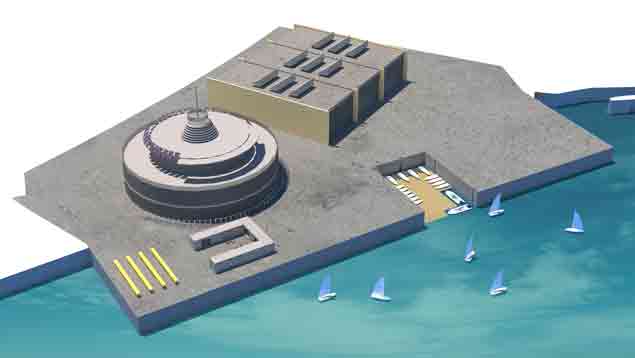 A graphic depicting Irish Sailing's proposed €300k facilities at its new 'Performance Head Quarters' in the grounds of the Commissioners of Irish Lights at Dun Laoghaire Harbour
A graphic depicting Irish Sailing's proposed €300k facilities at its new 'Performance Head Quarters' in the grounds of the Commissioners of Irish Lights at Dun Laoghaire Harbour
The Performance HQ will be entirely mobile and will consist of three converted shipping containers which have space for briefings and athlete education, a gym, gear storage and a boat maintenance area. The athlete briefing room can then be shipped directly to international competitions such as the Olympics in Tokyo 2020 and provide a base for our athletes overseas. Outside there will be a boat park and a pontoon for launching the boats.
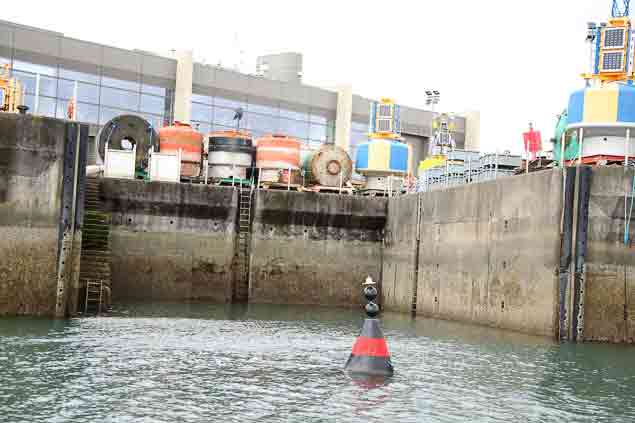 The Irish Lights berth today (above) and how it will be transformed for use (below) in the Performance HQ with a modular pontoon system and floating slipway in the dock
The Irish Lights berth today (above) and how it will be transformed for use (below) in the Performance HQ with a modular pontoon system and floating slipway in the dock

The new facility will provide senior sailing athletes with an improved, multi-dimensional performance environment. Regular events such as the Youth Sailing Nationals will continue to be hosted by clubs.
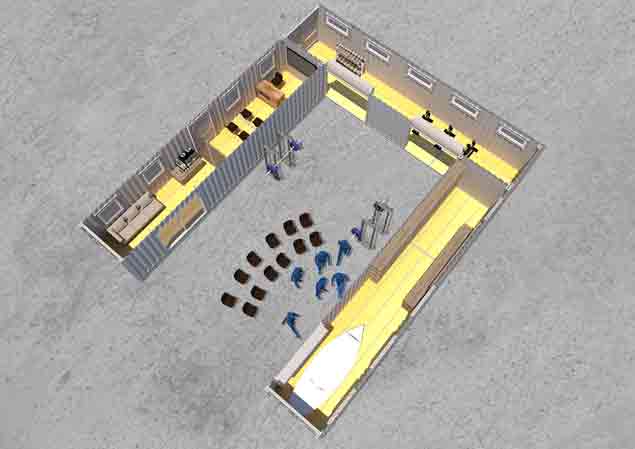 The Performance HQ will be mobile and consists of three converted shipping containers which have space for briefings and athlete education, a gym, gear storage and a boat maintenance area
The Performance HQ will be mobile and consists of three converted shipping containers which have space for briefings and athlete education, a gym, gear storage and a boat maintenance area
President of Irish Sailing Jack Roy, said “when philanthropic generosity is combined with a passion for Irish sporting success on the world stage we see results – in this instance a Performance HQ that will ensure a bright future for Irish Sailing.”
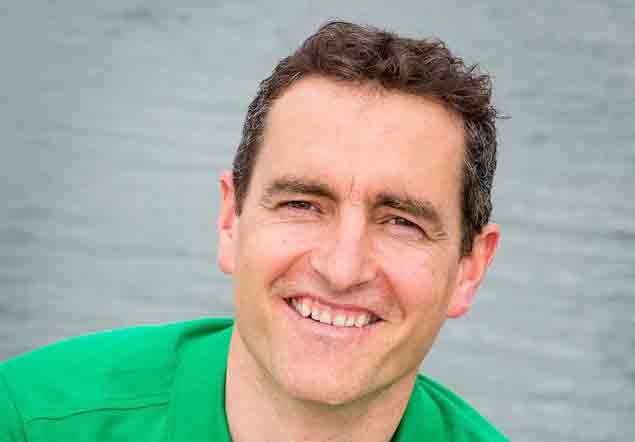 James O'Callaghan – 'the impact of the new Irish Sailing Performance HQ cannot be underestimated'
James O'Callaghan – 'the impact of the new Irish Sailing Performance HQ cannot be underestimated'
James O’Callaghan, Irish Sailing Performance Director added “lead by Rory Fitzpatrick our Head Coach, the impact of the new Irish Sailing Performance HQ can not be underestimated. We will finally have a place we can call “home”. The performance environment created will allow for consistent coaching, a base for equipment and our own direct access to the water which all adds up to give our athletes the best opportunities to reach their maximum potential”.
Subject to planning requirements, it is hoped that work will be completed by end of summer 2018
Olympic Sailing Shake Up for Paris 2024
After much debate at World Sailing’s Mid-Year Meeting, a new program of ten Events have been confirmed. While 7 Events at Tokyo 2020 will continue, there are three new events but little other detail, according to Craig Leweck in Scuttlebutt.
In what looks like major shake-up in Olympic sailing formats, Ireland's Olympic Silver Sailing Medalist Annalise Murphy demonstated her own ability for change last week with an announcement of a new campaign for Tokyo 2020, even though it appears her former Laser Radial and new 49erFx class will now both remain for Paris 2024.
5 Events to remain unchanged from Tokyo 2020:
- Men’s One Person Dinghy - Laser
- Women’s One Person Dinghy - Laser Radial
- Women’s Skiff - 49erFX
- Men’s Skiff - 49er
- Mixed Two Person Multihull - Nacra 17
Note: Equipment for One Person events subject to evaluation
2 Events to evolve from Tokyo 2020:
- Men’s Windsurfer
- Women’s Windsurfer
Note: Equipment and format subject to evaluation
3 new Events for Paris 2024:
- Mixed One-Person Dinghy
- Mixed Two Person Dinghy
- Mixed Kite
Of all the proposals, it was the submission from the Romanian Sailing Federation which was approved. What do we know about these 3 new Events? Not much at this stage.
There are bits of insight in the Romanian submission and the Formula Kite Class, which will be a new form of Sailing to participate in the Olympic Games. Additional statements come from the Finn Class and the 470 Class, which have been used in the Olympic Games since 1952 and 1976, respectively, and hope to retain that status.
The Romanian plan was for the Finn and 470 to remain in use, but all Equipment (ie, boat type) for these Events, or for any other Events for which the Equipment is being evaluated, won’t be decided until the 2018 World Sailing Annual Conference in November.
The challenges ahead are immense. While it is possible to create unique events for the Olympic Games, innovative formats then puts pressure on the Class Organisations which support the selected Equipment. Changes at the Olympic level can be transformative to the wider sport of Sailing.
The National Yacht Club's Olympic Laser sailor Finn Lynch continues to master further challenges in Hyeres as light winds dominated the third day of competition at the Sailing World Cup Series. The 22–year–old has moved up to 13th overall and is now only six points off the top ten overall in his 68–boat fleet.
In the mens 49er skiff dinghy, Ireland's Ryan Seaton and Seafra Guilfoyle also move up three places to 22nd overall in their 40–boat fleet.
The 647 sailors from 46 nations racing across the ten Olympic disciplines and one Para World Sailing event contested a variable 5-7knot breeze on day three which enabled the light wind specialists to move to the front of their fleets.
French sailors occupy the top three spots in the Men’s RS:X with Rio 2016 Olympic bronze medallist Pierre Le Coq (FRA) leading the way at the front of the fleet.
The fleet sailed two gruelling light wind races that involved an extreme amount of physical exertion as they pumped their sails to make gains.
In the tough conditions, Le Coq did enough to take the lead, “I managed to have a good first race, finishing seventh, but had a bad second race and finished 15th,” he commented.
“The conditions were physically draining and the fleet in these conditions were really close, so you couldn’t afford to make a mistake.
“It was difficult because of the uncertain weather and it was too shifty and quite challenging to predict what was going to happen. This made it hard to be consistent.”
Thomas Goyard (FRA) is three points off in second and Louis Giard (FRA) is third. On the success of the French in Hyères, Le Coq commented, “We train together and we train in Hyères quite often so we know the venue. It’s great to see this quality of windsurfing in France.”
Just one race was completed in the Women’s RS:X. Japan’s Megumi Komine claimed a rare victory, leaving her in 23rd place. Zofia Noceti-Klepacka (POL) retained her lead although it was dented by Peina Chen (CHN) who finished seventh compared to Klepacka’s tenth. Noga Geller (ISR) advanced to third overall after a second.
Anton Dahlberg and Fredrik Bergstrom (SWE) continued their consistency with a fifth and a second from two Men’s 470 races. They are five points clear of Paul Snow-Hansen and Dan Wilcox.
“It was a long day on the water,” said Dahlberg. “We had four races, two races got abandoned because the wind dropped but we had a great day with two great starts. Our plan was to keep it simple and we did that well.
“We are halfway through the regatta so far, so a lot can change but we feel very confident running up to the Medal Races.”
Japan’s Tetsuya Isozaki and Akira Takayanagi are 13 points off the leading Swedes in third.
Camille Lecointre’s comeback to the World Cup Series continues to go from strength to strength. Sailing with Aloise Retornaz, the French Rio 2016 Women’s 470 bronze medallist picked up a fifth and a fourth to take a six point lead over Silvia Mas and Patricia Reina (ESP) into Friday’s racing.
“We are in our home country and we do train here sometimes,” said Lecointre. “After finishing fourth in Palma recently, we hope to achieve a medal this time.
“However, we are just using this event to train to be ready for the [Hempel Sailing] World Championships in Aarhus, [Denmark].”
David Gilmour and Joel Turner (AUS) won the sole 49er race which was enough to propel them into the lead, overhauling Poland’s Dominik Buksak and Szymon Wierzbicki who led during the first two days.
The Polish duo finished 32nd in the race and although they discard it, they drop to third. Diego Botin and Iago Lopez (ESP) moved up to second after a fifth.
It is tight at the top in the 49erFX but Norway’s Helene Naess and Marie Ronningen continue to lead after one single race on Thursday. Denmark’s Ida Marie Nielsen and Marie Olsen reduced the deficit to four points to occupy second place. Meanwhile Alex Maloney and Molly Meech (NZL) slipped down to third but firmly in contention for gold.
The 17th placed Charlotte Dobson and Saskia Tidey (GBR) won the solitary race and sit in 17th place.
Damien Seguin (FRA) got back in the winning groove in the 2.4 Norlin OD, snapping up another pair of victories. He is now four points clear of Antonio Squizzato (ITA) and six ahead of compatriot Bruno Jourdren.
It was a late finish for the Finn fleet as they came ashore at 19:50. Nicholas Heiner (NED) leads, Jorge Zarif (BRA) follows in second place and Alican Kaynar (TUR) climbed up to third.
The Laser fleet managed to sail two races and although the conditions were similar to the day prior, a significant shift in the leader board occurred.
The early pacesetter, Tonci Stipanovic (CRO) finished 44th and 20th in two races. He discards the 44th but counting the 20th, he has dropped to sixth.
Jean Baptiste Bernaz (FRA) took the initiative and moved up to first but Lorenzo Chiavarini (GBR), Filip Jurisic (CRO), Sam Meech (NZL) and Tom Burton (AUS) are separated by just six points behind him.
In the Laser Radial, Marit Bouwmeester (NED) continues to hold first place however Maité Carlier (BEL) moved up from fifth to second. Finland’s Monika Mikkola shifted up one spot to third.
There was not much change on the Nacra 17 leaderboard. The Italians, Ruggero Tita and Caterina Marianna Banti, hold onto their lead after day three, whilst Ben Saxton and Nicola Boniface (GBR) remain second. The Brazilians, Samuel Albrecht and Bruna Martinelli Cesário de Mello, moved up one place and now sit third.
Friday’s racing will be the final day of fleet racing for the 2.4 Norlin OD, 49er, 49erFX, Nacra 17, Men’s RS:X and Women’s RS:X ahead of their Medal Races on Saturday 28 April.
The remaining fleets will complete their series on Saturday with Medal Races following on Sunday.
Birthday Boy Finn Lynch Moves Up to 14th Place in Tricky Hyeres
More solid results for Finn Lynch at the Sailing World Cup is the perfect birthday gift for the Laser Olympic helm in tricky and light winds in Hyeres on the Cote D'Azur.
The National Yacht Club single-hander scored a 21 and 17 on day 2 to move up to two places to 14th overall, six nett points off the top ten in a fleet of 68. Results here.
Lynch, who became Ireland's youngest ever Irish Olympic helmsman when he debuted in Rio age 20, turned 22 on April 23rd.
The other Irish boat competing this week, Lynch's Rio 2016 team mate, Ryan Seaton, now paired with Royal Cork's Seafra Guilfoyle in the 49er skiff, ended day two after five races in 25th place from a fleet of 40.
At 20:35 local time the last of the 647 sailors from 46 nations competing at the third round of Sailing’s World Cup Series ot back to the dock, marking the end of a long and challenging day.
A foggy morning with no wind became a sunny afternoon with a light 5-8 knot breeze that tested the sailors composure and patience with delays ashore and on the water.
Races were held across every fleet but only the RS:X competitors could complete their full schedule of races as the 49er competitors pulled down their sails under the glow of the marina lights to close the day.
For many years, the Polish RS:X team have based themselves in Hyères for Spring training and with plenty of time on the water, they know the venue well.
Success has followed in both the men’s and women’s categories and could well continue after Zofia Noceti Klepacka (POL), Hyères winner in 2008, 2016 and 2017 advanced to the top of the 44-boat fleet.
Klepacka, a London 2012 bronze medallist, sailed her way to a 5-1-6 scoreline and is seven points clear of China’s Peina Chen. Klepacka was relieved to be ashore after a grueling day in the light winds, "We were on land waiting to go out for quite some time, eating sandwiches and drinking coffee waiting for the wind," explained Klepacka. "When we went out to race we had to pump a lot which made us very tired.
"I am glad that we will start after the men tomorrow so we can get more time to recover so let’s pray for more wind so we can sail."
Much like Klepacka, Chen knows what it takes to achieve success in Hyères following a victory in 2009 and knows she has the skillset to move up the leaderboard, "On both days the wind hasn’t been stable and it’s been tiring for all of us to sail but I think I have really good strength," expressed Chen. "That is why I can compete against some of the best like Zofia and Noga [Geller (ISR)] who are really strong sailors."
In the Men’s RS:X, French sailors continue to occupy the top positions but a new leader has emerged. All of the top racers had a mixed day with good and bad scores combined but Louis Giard (FRA) did enough to grab top spot.
Sitting on 26 points, Giard is three clear of China’s Mengfan Gao and overnight leader Pierre Le Coq (FRA) who are tied.
Three challenging Nacra 17 races were held and Italy’s Ruggero Tita and Caterina Marianna Banti picked up a 1-(15)-4 scoreline to remove the early pacesetters, Ben Saxton and Nicola Boniface (GBR), from the top of the tree.
The Italians recently won gold at the Trofeo Princesa Sofia and finished third at the 2017 Nacra 17 World Championship.
They are lacking a World Cup medal but only have their eye on one colour, "We are here to win," exclaimed Banti. "We have some of the best here, including Santi and Cecilia, and Jason and Lisa. I think the Spanish, Fernando Echávarri and Tara Pacheco are also strong contenders.
"We will try out best and do whatever it takes. Our plan is to just sail as fast as we can."
Iker Martinez and Olga Masilvets (ESP) round up the podium with plenty of races ahead of the 30-boat fleet.
Helene Naess and Marie Rønningen (NOR) moved up to first overall in the 49erFX but New Zealand’s Alex Maloney and Molly Meech shone in the challenging conditions by picking up two race wins. The Kiwis are nine points off the leading Norwegians.
The day’s remaining race win went the way of Natasha Bryant and Annie Wilmot (AUS), 2016 Youth Sailing World Champions in the 29er, who are making only their second World Cup Series appearance.
Poland’s Dominik Buksak and Szymon Wierzbicki and Australia’s David Gilmour and Joel Turner continue to do battle in the 49er fleet. From two light wind races in a dying twilight breeze, the Polish team picked up a 19th, which they discard and an eighth. Meanwhile, the Australians won a race and count the 13th from the other.
Just one point separates them with two more days of fleet racing remaining. Belgium’s Yannick Lefèbvre and Tom Pelsmaekers are eight points off the leading duo in third.
The 470 Men and Women only managed to complete one race but this saw major shifts on the leaderboards as the discard came into play.
The Japanese team of Tetsuya Isozaki and Akira Takayanagi ascended from seventh to first place, and the Swedes, Anton Dahlberg and Fredrik Bergström drop to second. Paul Snow-Hansen and Daniel Willcox (NZL) occupy third.
In the Women’s 470, Noya Bar-Am and Nina Amir (ISR) made their way from tenth to first on the, and the Chinese, Mengxi Wei and Haiyan Gao, drop from first to second. Silvia Mas Depares & Patricia Cantero Reina (ESP) hold third place.
Jonathan Lobert (FRA) managed to retain his lead in the Finn despite not finishing his third race. Nicholas Heiner (NED) climbed up from fifth place and finished second whilst Jorge Zarif (BRA) drops from second to third place.
The Laser Radial has proven to be a tough competition between the top racers, even after just four close races. The fleet managed two races which saw a shift between Marit Bouwmeester (NED) and Paige Railey (USA).
Bouwmeester now holds top position overnight, moving up one place whilst Railey dropped to second. Viktorija Andrulyte (LTU) maintains third place.
The Laser pack also managed to complete two races on day two. Tonci Stipanovic (CRO) continues to hold top spot after discarding his fourth race. Jean Baptiste Bernaz (FRA) capitalised in the light winds and moved up from fourth to second, whilst Pavlos Kontides (CYP) dropped from second to third.
Antonio Squizzato (ITA) broke Damien Seguin’s (FRA) winning run in the 2.4 Norlin OD as he picked up the victory in the third race of the series, the only race the fleet held on the second day. The Italian is now just two points behind the flying Frenchman.
Racing will resume at 11:00 this morning, Thursday 26 April.
The National Yacht Club's Olympic sailor Finn Lynch is in the top quarter of his Laser fleet after the first two races of Sailing’s World Cup Series in Hyères, France yesterday. In what amounts to a good start for the two Irish Olympic sailing team boats competing, 49er skiff pair Ryan Seaton and Seafra Guilfoyle are just outside the the top half of their 40-boat fleet in 21st position after three races sailed.
Buoyed up by his final race exploits in Palma earlier this month, Laser dinghy ace Lynch took a 31 and and 11 to make a solid start on the Cote D'Azur under his National Yacht Club. He lies 16th from 68.
Results so far are here
The opening scene at the third round of the Cup saw the 647 sailors from 46 nations remain cautious as they laid down markers to build on for a full week of competition.
In a variable 6-11 knot easterly breeze, the competitors looked to achieve good finish positions that would put them in a strong place on the leaderboard for the latter part of the week.
The early races have set the scene and with a light wind forecast ahead, it’s going to be a mesmerising week of competition with all the competitors expecting more close racing.
Video highlights from the opening day are below.
The 49er features 40 strong teams and Poland’s Dominik Buksak and Szymon Wierzbicki had the best of the day, recording a 3-(5)-1 scoreline. They are tied on four points at the top of the leaderboard with David Gilmour and Joel Turner (AUS).
"We started well and that was the key to winning today. Because the shifts weren’t very big, that allowed us to stay at the front from the beginning of the race," explained Buksak on the secret to their consistent performance as those around them failed to do so.
"Our opponents were our biggest challenge," continued Buksak. "We have some top sailors here and it’s a pleasure competing with them. Now that we are on the top, we will try our best to stay there and sail our best throughout the week."
Although the Australians are tied with the Polish team, they picked up a 27th in the final race of the day, which they discard, meaning they’ll have to have a degree of caution for the rest of the week. "We started off pretty well in all our races," said Gilmour, "but we found the wind to be quite tricky because weren’t sure of the wind speeds and shifts.
"In our last race, the wind speed just died, and it was tough competing in that. It was quite packed and highly competitive but that’s what makes World Sailing regattas different because you always get larger 49er fleets."
Turner concluded, "Having a 40-boat fleet, it was tight racing and we couldn’t afford to make any mistakes."
New Zealand’s Logan Dunning Beck and Oscar Gunn follow the leading duo in third.
In the 49erFX, just two races were completed. Denmark’s Ida Marie Nielsen and Marie Thusgaard Olsen snapped up both race victories to open up an early five point lead over Norway’s Helene Naess and Marie Rønningen.
In a bid to win his tenth title in the 2.4 Norlin OD in Hyères, Damien Seguin (FRA) could not have had a better start. The Frenchman won two out of two races and was pleased with his performance, "Today was a beautiful day and a great start to the competition.
"The first race was good, we had 8 knots, but the second race was quite hard because the wind speed dropped to 6 knots and it was a long race – about an hour.
"I would say that I am quite competitive, and I like to win. That kind of hunger makes me push myself and that is how I win most races."
Seguin’s compatriots Bruno Jourdren and Xavier Dagault follow in second and third.
Sixty eight sailors are competing in the Laser fleet in Hyères with nine of the world’s top ten racers and the three Rio 2016 Olympic medallists spearheading the fleet.
In such a highly competitive fleet it’s uncommon for one racer to maintain consistency and dominate. The norm was smashed to bits by Rio 2016 silver medallist Tonci Stipanovic (CRO) who won both the day’s races by huge margins.
"On my first race, I was struggling at the start and kept my main focus in mind," explained Stipanovic. "My plan was to reach the left side, which I did eventually, and then tack for the mark. It was a good plan and it paid off.
"The second race was good, but I struggled with speed but the guys on the right had more pressure, so I decided to tack and clear to the right side which put me back on top."
If today wasn’t good enough for the Croatian, he concluded by putting out a further warning to his rivals, "I hope that tomorrow I will be faster." Pavlos Kontides (CYP) and Lorenzo Chiavarini (GBR) follow in second and third.
Paige Railey (USA) imitated Stipanovic in the Laser Radial by taking another pair of victories. She is followed by Marit Bouwmeester (NED) and Viktorija Andrulyte (LTU).
The Finn fleet was the last to conclude racing as the breeze began to decrease towards the latter part of the day. Race victories went the way of Nicholas Heiner (NED) who is fifth overall and the second placed overall sailor, Jorge Zarif (BRA). Jonathan Lobert (FRA) sailed his way to a second and third which sees him lead.
Pierre Le Coq (FRA) was in fine form on his home waters in the Men’s RS:X fleet. The Frenchman, Rio 2016 bronze medallist, took two races wins and a fourth and holds a narrow lead over Mengfan Gao (CHN) who won the final race of the day.
Only Gao separates Le Coq from three of his compatriots, Thomas Goyard, Louis Giard and Oël Pouliquen who are firmly in the hunt in third, fourth and fifth respectively.
In the Women’s RS:X, Peina Chen (CHN) and Noga Geller (ISR) are locked on five points each at the top of the pack. Hei Man Chan (HKG) and Maya Morris (ISR) are joint third on eight points apiece.
China’s Mengxi Wei and Haiyan Gao grabbed the early advantage in the Women’s 470 and are two points clear of Hannah Mills and Eilidh McIntyre (GBR). Camille Lecointre, Rio 2016 bronze medallist, making her first World Cup appearance with Aloise Retornaz (FRA), won the first race of the day and is third overall.
Anton Dahlberg and Fredrik Bergström (SWE) are top in the Men’s 470 fleet, two points ahead of Hao Lan and Bo Zhou (CHN). Race victories went to Paul Snow Hansen and Dan Wilcox (NZL) and Tetsuya Isozaki and Akira Takayanagi (JPN).
The single Nacra 17 race win went the way of Ben Saxton and Nicola Boniface (GBR). They were followed by Ruggero Tita and Caterina Marianna Banti (ITA) and Iker Martinez and Olga Masilvets (ESP).
Racing will resume on Wednesday 25 April at 11:00 local time.
The prospect of the ever–looming Olympic qualifier this August in Aarhus will weigh heavy on the minds of Ireland’s Olympic sailors Finn Lynch and Ryan Seaton who compete in the Sailing World Cup in Hyeres next week.
Lynch in the Laser, with Ryan Seaton and Seafra Guilfoyle in the 49er head to France to begin racing next Tuesday at World Sailing’s Sailing World Cup. With cobwebs officially brushed off after the Princess Sofia event (Lynch made Gold fleet in Palma but Seaton and Guilfoyle raced in silver) all 650 competitors from 46 nations are primed to go after a hard winter’s training.
The World Cup series is a series of sailing regattas which offer sailors an opportunity to qualify for the World Cup Final. Hyeres is one of the toughest World Cups of the series, which includes events in Gamagori (Japan); Miami and Hyeres, culminating in the World Cup Final in Marseille.
Irish Olympic Sailors Add Genoa as World Sailing Cup Heads for Italy in 2019 and 2020
Irish Olympic Sailors such as silver medalist Annalise Murphy can look forward to an Italian regatta in their campiagns to Tokyo 2020 following yesterday's announcement that Sailing's World Cup Series, the annual circuit for Olympic sailing and Para World Sailing, will touch down in Genoa, Italy in 2019 and 2020 for the European stopover.
Listen into the prospects of Irish sailors on the Afloat.ie podcast with Irish Olympic Sailing Team Manager James O'Callaghan here. This week it was also announced that star team member Murphy has opted out of August's World Sailing Championships in August leaving the Irish berth open to Tokyo rival Aoife Hopkins.
Organised by World Sailing in collaboration with the Federazione Italiana Vela and Yacht Club Italiano, the Fiera di Genova will host sailors in Spring 2019 and 2020. Set against a dramatic coastline, with racing areas perfectly positioned in front of Genoa's seafront.
The 2019 Series will start at the Tokyo 2020 Olympic venue in Enoshima, Japan this September, before heading to Miami, USA in January. Genoa will be the final opportunity for sailors' to qualify outright for the World Cup Finals, which will be held in Marseille, France, the venue for the Paris 2024 Olympic Sailing Competition.
Enoshima will also host the first event of the 2020 series in the autumn of 2019, with Miami following early in the New Year. Genoa will be one of the last big European Olympic class events before sailors' head back to Enoshima for the 2020 World Cup Final; which will swiftly be followed by the Tokyo 2020 Olympic Sailing Competition.
The World Cup Series is a key touchpoint for fans and media to connect to the sport of sailing and develop support for athletes on their road to Tokyo 2020 and beyond. Over 2,000 of the world's leading sailors, representing 75 nations, have competed in the World Cup Series since its inception in 2008.




























